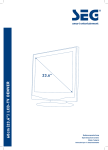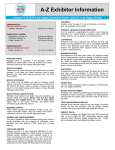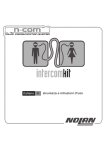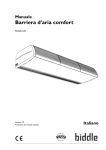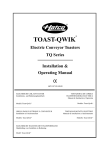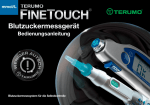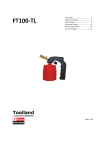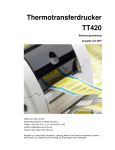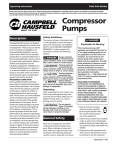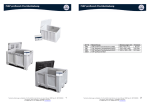Download toneohm 850a - Artisan Technology Group
Transcript
Artisan Technology Group is your source for quality new and certified-used/pre-owned equipment • FAST SHIPPING AND DELIVERY • TENS OF THOUSANDS OF IN-STOCK ITEMS • EQUIPMENT DEMOS • HUNDREDS OF MANUFACTURERS SUPPORTED • LEASING/MONTHLY RENTALS • ITAR CERTIFIED SECURE ASSET SOLUTIONS SERVICE CENTER REPAIRS Experienced engineers and technicians on staff at our full-service, in-house repair center WE BUY USED EQUIPMENT Sell your excess, underutilized, and idle used equipment We also offer credit for buy-backs and trade-ins www.artisantg.com/WeBuyEquipment InstraView REMOTE INSPECTION LOOKING FOR MORE INFORMATION? Visit us on the web at www.artisantg.com for more information on price quotations, drivers, technical specifications, manuals, and documentation SM Remotely inspect equipment before purchasing with our interactive website at www.instraview.com Contact us: (888) 88-SOURCE | [email protected] | www.artisantg.com Polar Instruments Ltd. Garenne Park Rue de la Cache St. Sampson Guernsey Channel Islands GY2 4AF England http://www.polar.co.uk TONEOHM 850A OPERATOR MANUAL Fax: +44 (0)1481 252476 Email: [email protected] MAN 150-9803 Artisan Technology Group - Quality Instrumentation ... Guaranteed | (888) 88-SOURCE | www.artisantg.com Artisan Technology Group - Quality Instrumentation ... Guaranteed | (888) 88-SOURCE | www.artisantg.com TONEOHM 850A SHORTS LOCATOR OPERATOR MANUAL POLAR INSTRUMENTS LTD. HARDWARE WARRANTY 1. Product Warranty. Product hardware is warranted to be free from defects in material and workmanship during the Warranty Period (as defined below). Product hardware is warranted to conform substantially to Polar’s then current (as of the date of Polar’s product shipment) published user documentation during the Warranty Period. The Warranty Period is twelve (12) months. Product support beyond these periods may be available at additional cost – consult Polar for details. 2. Warranty Claims. Polar shall incur no liability under this warranty if the end user fails to provide Polar with notice of the alleged defect during the applicable Warranty Period and within seven (7) days of delivery to end user or, if the defect would not have been reasonably apparent on inspection, within seven (7) days of its discovery by end user. After receiving such notice, Polar will notify the purchaser of its designation of one of the following problem resolution methods: Return to Factory: The allegedly defective goods must be returned to Polar within seven days of Polar’s notice and in accordance with Polar’s instructions advised at the time. Other: Polar will use commercially reasonable efforts to repair, correct or work around the problem by means of telephone support or other means reasonably determined by Polar. Polar shall incur no liability under this warranty if Polar’s tests disclose that the alleged defect is due to causes not within Polar’s reasonable control, including alteration or abuse of the goods. Under the Return to Factory alternative, if a Product is determined not to be defective or to have a defect due to causes not within Polar’s reasonable control, Polar reserves the right to apply a processing charge. 3. Damage in Transit. End user must notify Polar and the carrier of any claim for damage in transit within two (2) days of receipt of the damaged merchandise. Failure to do so may result in the carrier and/or Polar refusing to accept liability in which case end user must pay the purchase price as if the hardware had been delivered without damage. 4. Polar’s Liability Polar’s liability, and end user’s sole and exclusive remedy, shall be limited to the express remedies set forth in this Polar Hardware Warranty. 5. Disclaimer of Warranties. POLAR MAKES NO OTHER WARRANTIES, EXPRESS, IMPLIED OR STATUTORY, REGARDING PRODUCTS. ALL OTHER WARRANTIES AS TO THE QUALITY, CONDITION, MERCHANTABILLITY, FITNESS FOR A PARTICULAR PURPOSE, OR NON-INFRINGEMENT ARE EXPRESSLY DISCLAIMED. 6. Limitation of Liability. POLAR SHALL NOT BE RESPONSIBLE FOR DIRECT DAMAGES IN EXCESS OF THE PURCHASE PRICE PAID BY THE END USER OR FOR ANY SPECIAL, CONSEQUENTIAL, INCIDENTAL, OR PUNITIVE DAMAGE, INCLUDING, BUT NOT LIMITED TO, LOSS OF PROFITS OR DAMAGES TO BUSINESS OR BUSINESS RELATIONS, WHETHER OR NOT ADVISED IN ADVANCE OF THE POSSIBILITY OF SUCH DAMAGES, THE FOREGOING LIMITATIONS SHALL APPLY, NOTWITHSTANDING THE FAILURE OF ANY EXCLUSIVE REMEDIES. Copyright Polar Instruments Ltd. 1995 Artisan Technology Group - Quality Instrumentation ... Guaranteed | (888) 88-SOURCE | www.artisantg.com TONEOHM 850A OPERATOR MANUAL DECLARATIONS European Community Directive Conformance Statement This product conforms to all applicable EC Council Directives, including: EC Council Directive 89/336/EEC on the approximation of the laws of the Member States relating to electromagnetic compatibility. EC Council Directive 73/23/EEC on the harmonisation of the laws of the Member States relating to electrical equipment designed for use within certain voltage limits. A declaration of conformity with the requirements of these Directives has been signed by: POLAR INSTRUMENTS (UK) LTD 11 College Place London Road Southampton England SO1 2FE Harmonised standards applied in order to verify compliance with these Directives: EN 50081-1:1992 EN 50082-1:1992 EN 61010-1:1993 ii Artisan Technology Group - Quality Instrumentation ... Guaranteed | (888) 88-SOURCE | www.artisantg.com INTRODUCTION SAFETY WARNING The LIVE and NEUTRAL lines on this unit are BOTH fused. This unit contains no user-serviceable parts. When the unit is connected to its supply, the opening of covers or removal of panels is likely to expose dangerous voltages. To maintain operator safety, do not operate the unit unless the enclosure is complete and securely assembled. GROUNDING This unit must be earthed (grounded); do not operate the instrument with the safety earth disconnected. Ensure the instrument is connected to an outlet with an effective protective conductor terminal (earth). Do not negate this protective action by using an extension cord without a protective conductor. Note: This instrument is fitted with 3-wire grounding type plug designed to fit only into a grounding type power outlet. If a special local plug must be fitted to the power cord ensure this operation is performed by a skilled electronics technician and that the protective ground connection is maintained. The plug that is cut off from the power cord must be safely disposed of. Power cord color codes are as follows: Europe brown blue green/yellow live neutral earth (ground) United States black white green live neutral ground iii Artisan Technology Group - Quality Instrumentation ... Guaranteed | (888) 88-SOURCE | www.artisantg.com TONEOHM 850A OPERATOR MANUAL POWER SUPPLY Check that the indicated line voltage setting corresponds with the local mains power supply. See the rear panel for line voltage settings. To change the line voltage settings refer the instrument to a skilled electronics technician. Instructions for changing the line voltage settings are contained in the TONEOHM 850A Service Manual published by Polar Instruments. TONEOHM 850A OPERATION This manual contains instructions and warnings which must be observed by the user to ensure safe operation. Operating this instrument in ways other than detailed in this manual may impair the protection provided by the instrument and may result in the instrument becoming unsafe. Retain these instructions for later use. The TONEOHM 850A is designed for use indoors in an electrical workshop environment at a stable work station comprising a bench or similar work surface. Use only the accessories (e.g. test probes and clips) provided by Polar Instruments. The TONEOHM 850A must be maintained and repaired by a skilled electronics technician in accordance with the manufacturer’s instructions. If it is likely that the protection has been impaired the instrument must be made inoperative, secured against unintended operation and referred to qualified service personnel. Protection may be impaired if, for example, the instrument: • • • • • Shows signs of physical damage Fails to operate normally when the operating instructions are followed Has been stored for prolonged periods under unfavourable conditions Has been subjected to excessive transport stresses Has been exposed to rain or water or been subject to liquid spills iv Artisan Technology Group - Quality Instrumentation ... Guaranteed | (888) 88-SOURCE | www.artisantg.com INTRODUCTION SPECIFICATIONS Resistance Ranges Number of Ranges Hi sensitivity Ω 200mΩ 2Ω 200Ω 20kΩ Probe tip voltage Probe Protection 5 Approx. 40mΩ, uncalibrated 200mΩ, 4% 2Ω, 4% 200Ω, 4% 20kΩ, 4% 60mV max. Momentary contact to 100V Voltage Ranges 2mV 20mV 2V 20V 2mV, 4%, ±15µV (Rin=120Ω) 20mV, 4%, ±15µV (Rin=120Ω) 2V, 4%, ±15µV (Rin=1MΩ) 20V, 4%, ±15µV (Rin=1MΩ) Current Trace Sensitivity Detects current flow with 200Ω connected to Drive Source Drive Source 0-550mV, adjustable Display 0.7”, 3½ digit LCD Tone Internal speaker, headphone socket, adjustable volume Power Cord Detachable ENVIRONMENTAL OPERATING CONDITIONS The instrument is designed for indoor use only under the following environmental conditions: Altitude Temperature Relative humidity Mains borne transients Pollution Degree Up to 2000m +5°C to +40°C ambient RH 80% maximum at 31°C — derate linearly to 50% at 40°C As defined by Installation Category II (Overvoltage Category II) in IEC664 2 (IEC664) v Artisan Technology Group - Quality Instrumentation ... Guaranteed | (888) 88-SOURCE | www.artisantg.com TONEOHM 850A OPERATOR MANUAL Power Requirements 230V ± 10%, 115V ± 10% or 100V ± 10% at 50/60Hz, 15VA. Physical characteristics (excluding accessories) Dimensions 300 mm (11.8 in.) wide 110 mm (4.4 in.) high 260 mm (10.3 in.) deep Weight 1.5 kg (3.3 lb.) ACCESSORIES Standard Accessories Needle Probe set Current Trace Probe Drive Source Clips Operator manual ACC152 ACC34 ACC33 MAN150 SYMBOLS CAUTION — To prevent damage to this product and to ensure its safe use observe the specifications given in this manual when connecting to terminals marked with this symbol. vi Artisan Technology Group - Quality Instrumentation ... Guaranteed | (888) 88-SOURCE | www.artisantg.com INTRODUCTION GUIDE TO THE MANUAL INTRODUCTION An overview of the Polar TONEOHM 850A shorts locator and its applications. GENERAL DESCRIPTION The principles of operation of the TONEOHM 850A; selecting the operating mode for different types of short circuit. Front and rear panel connectors. INSTALLATION AND SET UP Connecting the TONEOHM 850A to a power supply. MILLIOHMMETER Using the resistance measurement ranges of the TONEOHM 850A to locate low resistance short circuits TRACK VOLTAGE Making track voltage measurements with the TONEOHM 850A to locate high resistance shorts and “loading” faults. CURRENT TRACING Non-contact current tracing with the TONEOHM 850A. Using board sectoring techniques to pin-point faults on printed circuit boards. Locating shorts in wire-looms and backplanes. SIMPLE MAINTENANCE Details of maintenance and cleaning procedures. vii Artisan Technology Group - Quality Instrumentation ... Guaranteed | (888) 88-SOURCE | www.artisantg.com TONEOHM 850A OPERATOR MANUAL CONTENTS DECLARATIONS..........................................................................................................................................ii European Community Directive Conformance Statement .................................................................... ii SAFETY.......................................................................................................................................................iii WARNING ............................................................................................................................................... iii GROUNDING........................................................................................................................................... iii POWER SUPPLY .................................................................................................................................... iv TONEOHM 850A OPERATION............................................................................................................... iv SPECIFICATIONS........................................................................................................................................v ENVIRONMENTAL OPERATING CONDITIONS ..................................................................................... v ACCESSORIES ....................................................................................................................................... vi Standard Accessories .......................................................................................................................... vi SYMBOLS................................................................................................................................................ vi SECTION 1 – INTRODUCTION ................................................................................................................1-1 INTRODUCTION TO THE TONEOHM 850A ........................................................................................1-1 1-1 Using the TONEOHM 850A to locate short circuits .....................................................................1-1 TONEOHM 850A applications ...................................................................................................1-1 TONEOHM 850A display mechanisms ......................................................................................1-1 SECTION 2 – DESCRIPTION ...................................................................................................................2-1 LOCATING SHORT CIRCUITS WITH THE TONEOHM 850A .............................................................2-1 2-1 TONEOHM 850A shorts locating modes .....................................................................................2-1 Milliohmmeter.............................................................................................................................2-1 Track Voltage .............................................................................................................................2-1 Current Tracer............................................................................................................................2-1 2-2 Controls, connectors and probes.................................................................................................2-1 Controls ......................................................................................................................................2-1 RESISTANCE range switches ...................................................................................................2-1 TRACK VOLTAGE range switches ............................................................................................2-2 DRIVE SOURCE control ............................................................................................................2-2 VOLUME control ........................................................................................................................2-2 Audio tone output .......................................................................................................................2-2 Connectors .................................................................................................................................2-2 Headphone socket .....................................................................................................................2-2 Current trace probe and drive source leads...............................................................................2-2 Needle probes ............................................................................................................................2-3 2-3 Rear Panel controls and connectors............................................................................................2-3 2-4 Mode and range selection............................................................................................................2-3 SECTION 3 – INSTALLATION AND SET-UP...........................................................................................3-1 PREPARATION FOR USE ....................................................................................................................3-1 3-1 Unpacking....................................................................................................................................3-1 3-2 Connecting the TONEOHM 850A to a power supply...................................................................3-1 viii Artisan Technology Group - Quality Instrumentation ... Guaranteed | (888) 88-SOURCE | www.artisantg.com INTRODUCTION SECTION 4 – MILLIOHMMETER .............................................................................................................4-1 LOCATING SOLDER AND LAND BRIDGES ........................................................................................4-1 4.1 (Low resistance) shorts................................................................................................................4-1 Tracing faults on double sided boards .......................................................................................4-1 SECTION 5 – TRACK VOLTAGE.............................................................................................................5-1 USING TRACK VOLTAGE TO LOCATE LOADING FAULTS ..............................................................5-1 5-1 TRACK VOLTAGE shorts locating mode ....................................................................................5-1 Static faults ................................................................................................................................5-1 Excessive Vcc Loads .................................................................................................................5-1 Dynamic faults ...........................................................................................................................5-2 SECTION 6 – CURRENT TRACING.........................................................................................................6-1 NON-CONTACT CURRENT TRACING ................................................................................................6-1 6-1 Using the 850A Drive Source ......................................................................................................6-1 Connection and Sensitivity Adjustment......................................................................................6-2 6-2 Operation .....................................................................................................................................6-2 Board Sectoring .........................................................................................................................6-2 Bus Faults (Stuck Nodes) ..........................................................................................................6-3 Edge Connectors .......................................................................................................................6-5 Faulty Decoupling Capacitors ....................................................................................................6-6 SECTION 7 – SIMPLE MAINTENANCE AND CLEANING ......................................................................7-7 Cleaning.............................................................................................................................................7-7 Technical Support..............................................................................................................................7-7 USER GUIDE (FRENCH) USER GUIDE (GERMAN) USER GUIDE (ITALIAN) ix Artisan Technology Group - Quality Instrumentation ... Guaranteed | (888) 88-SOURCE | www.artisantg.com Artisan Technology Group - Quality Instrumentation ... Guaranteed | (888) 88-SOURCE | www.artisantg.com SECTION 1 – INTRODUCTION INTRODUCTION TO THE TONEOHM 850A Short circuits and loading problems are a common cause of faults in electronic instrumentation both at the manufacturing stage and in service and repair. These faults may range from a low resistance short, such as a solder bridge on a printed circuit board, to a defective component loading down a bus line in a complex microprocessor system. 1-1 Using the TONEOHM 850A to locate short circuits With the TONEOHM 850A the operator has the choice of three operating modes to locate any type of short circuit without damaging the board under test: Milliohmmeter For locating low resistance shorts. Track Voltage Measuring the voltage drop caused by current flow through a track. Useful when tracing loading faults and high resistance shorts. Current Trace Non-contact current tracing where access to tracks or components is difficult. TONEOHM 850A applications The high accuracy of the TONEOHM 850A allows it to be used for a wide variety of applications requiring low resistance measurements: • Continuity testing • Relay and switch contact measurements • Detecting and measuring high-resistance connections • Measurement of transformer winding resistance • Testing for shorts and partial shorts between transformer windings TONEOHM 850A display mechanisms The TONEOHM 850A incorporates two mechanisms for notifying the operator of the proximity of a short circuit, a liquid crystal display digital readout and a highly sensitive variable-frequency audio tone output. The inclusion of the audio tone system allows the operator to maintain visual contact with the circuit under test while tracing through dense or complex wiring. The TONEOHM 850A will rapidly pin-point the physical location of short circuits, in many cases to within 0.2 inches, both on PC boards in isolation and within circuit wiring without the need to disconnect associated components or wiring. Artisan Technology Group - Quality Instrumentation ... Guaranteed | (888) 88-SOURCE | www.artisantg.com Artisan Technology Group - Quality Instrumentation ... Guaranteed | (888) 88-SOURCE | www.artisantg.com SECTION 2 – DESCRIPTION LOCATING SHORT CIRCUITS WITH THE TONEOHM 850A 2-1 TONEOHM 850A shorts locating modes The TONEOHM 850A provides three shorts locating modes to enable the user to physically locate any type of short circuit without lifting components, cutting tracks or otherwise damaging the board under test: Milliohmmeter This mode will be found highly effective in locating low resistance shorts. Track Voltage Trace current flow from the voltage drops caused by the current flowing in a track. Used when tracing loading faults and high resistance shorts. Current Tracer Use when non-contact current tracing is required, where access to tracks or components is difficult. Milliohmmeter The 850A includes resistance ranges (Ω and 200mΩ) which will prove sensitive enough for measuring circuit board track resistance. These resistance ranges will prove effective in locating low resistance shorts. In many cases, short circuits may be pin-pointed to within 0.2 inches of actual fault location without the need to disconnect associated components or wiring. Higher resistance ranges (2Ω, 200Ω and 20kΩ) are included for general purpose resistance measurements. Track Voltage Selecting Track Voltage enables current flow to be traced by measuring the voltage drop caused by the current flowing in a track. This technique will be found effective when tracing loading faults and high resistance shorts. Current Tracer The 850A Current Tracer is most effective where access to tracks or components is difficult, i.e., when non-contact current tracing is required. 2-2 Controls, connectors and probes Controls RESISTANCE range switches The RESISTANCE ranges (Ω, 200mΩ and 2Ω). are used to locate low resistance shorts. When locating faults on heavier tracks, use the Ω range to gain more sensitivity and resolution. Use the 200Ω, 20KΩ ranges for general resistance measurements. Artisan Technology Group - Quality Instrumentation ... Guaranteed | (888) 88-SOURCE | www.artisantg.com TONEOHM 850A OPERATOR MANUAL When using the milliohmmeter ranges, the open circuit probe tip voltage is limited to a maximum of 60mV to prevent any damage to sensitive components. TRACK VOLTAGE range switches The TRACK VOLTAGE ranges (2mV – 20V) allow the operator to trace current through a printed circuit board track from the voltage drop along sections of the track. The displayed value corresponds to the voltage along the track. The 20mV and 2mV ranges are particularly useful where the tracks are wide (i.e. very low resistance). DRIVE SOURCE control The TONEOHM 850A’s Drive Source drives current through the circuit under test — the resulting magnetic field may be detected using the Current Trace Probe. The maximum voltage generated by the Drive Source is 550mV, which will not damage devices or turn on silicon junctions. The DRIVE SOURCE control is used to adjust the amplitude of the DRIVE SOURCE current. The DRIVE SOURCE LED indicates flow of Drive Source current. If the LED does not light, either the leads are connected incorrectly, or there may be insufficient current flowing for the Current Trace Probe to detect the resulting field. VOLUME control The VOLUME control varies the sound level of the audible tone. Audio tone output The TONEOHM 850A incorporates a variable-frequency audio tone output to enable the operator to maintain continuous visual contact with the circuit under test. Connectors Headphone socket When the headphones are connected to this socket the internal speaker is switched off and the tone switched to the headphones. Use only 3.5mm stereo jack plugs in this socket. The TONEOHM 850A is supplied with two sets of probes and Drive Source leads. Each probe fits into a unique socket on the front panel. Current trace probe and drive source leads The magnetic Current Trace Probe is used to detect currents flowing through tracks, components, etc., without making physical contact. The Probe must be used in conjunction with the Drive Source output, as it is tuned to the frequency of the AC current supplied by the Drive Source when TRACE is selected. The Drive Source leads (a pair of red and black clips) are used to inject the current into the board. When Track Voltage ranges are selected the Drive Source output is a DC voltage (red clip positive) which can be used to stimulate the board under test. 2-2 Artisan Technology Group - Quality Instrumentation ... Guaranteed | (888) 88-SOURCE | www.artisantg.com DESCRIPTION Needle probes The Needle Probes are used in all ranges except TRACE. The red (positive) and black (negative) markings on the probes indicate direction of current flow Track Voltage. 2-3 Rear Panel controls and connectors The rear panel accommodates the push button (push-on/push-off) ON/OFF mains power switch and the IEC mains inlet connector. 2-4 Mode and range selection Different types of short circuit and loading faults require different location techniques. It is often possible to find the fault in more than one way, but the following guidelines may prove helpful in deciding the most appropriate shorts locating mode and range. In some cases a mixture of techniques may be required. When selecting the range to use, consider the following questions: 1. Is the fault a low resistance short (i.e. less than 200mΩ)? 2. Is the fault “static” or “dynamic”? I.e. is the fault always present (static) or only present when the board is powered (dynamic)? The operator will probably find the Milliohmmeter technique most appropriate in locating static, low resistance shorts on both single and double-sided boards. If the fault is dynamic use Track Voltage mode. 3. Are the tracks or cables associated with the short accessible? If access is difficult (e.g. a wire harness or densely packed memory bank) it will probably be most appropriate to use the Current Trace Probe, i.e. to detect current without making contact. 4. Does the short involve a plane in a multi-layer board? In this case the operator should use Track Voltage mode. 2-3 Artisan Technology Group - Quality Instrumentation ... Guaranteed | (888) 88-SOURCE | www.artisantg.com TONEOHM 850A OPERATOR MANUAL The table below indicates the suggested range for locating different types of short circuit. Type of fault Shorts below 200mΩ Excessive Vcc loads (static) Excessive Vcc loads (dynamic) Multi-layer shorts (dynamic) Bus faults Backplanes/wiring harnesses Open Circuit Capacitor Range Ω, 200mΩ 2mV/20mV 2mV/20mV TRACE TRACE TRACE TRACE Drive Source Used NO YES NO YES YES YES YES PCB Powered NO NO YES NO NO NO NO Table 2-1 850A Short Location ranges 2-4 Artisan Technology Group - Quality Instrumentation ... Guaranteed | (888) 88-SOURCE | www.artisantg.com SECTION 3 – INSTALLATION AND SET-UP PREPARATION FOR USE 3-1 Unpacking The instrument is shipped in a sturdy transit pack. Open the pack carefully and remove the instrument and its accessories. If the instrument is damaged in any way contact the local distributor or supplier. Retain the pack for possible future use. The TONEOHM 850A pack should contain: TONEOHM 850A Power cord Pair of needle probes Current Trace Probe Drive Source leads Operator manual Note: If the instrument has been shipped or stored in a cold environment, allow the instrument to reach the temperature of its new location before applying power. 3-2 Connecting the TONEOHM 850A to a power supply Refer to the voltage label on the rear panel of the instrument and make sure that the marked rating is suitable for the local mains power supply. If the rating on the label is not suitable for the local power supply refer the instrument to a skilled electronics technician. Instructions for changing the line voltage settings are contained in the TONEOHM 850A Service Manual. Note: If a special local plug must be fitted to the power cord ensure this operation is performed by a skilled electronics technician and that the protective ground connection is maintained. The plug that is cut off from the power cord must be safely disposed of. Power cord color codes are as follows: Europe brown blue green/yellow live neutral earth (ground) United States black white green live neutral ground Artisan Technology Group - Quality Instrumentation ... Guaranteed | (888) 88-SOURCE | www.artisantg.com TONEOHM 850A OPERATOR MANUAL Check that the TONEOHM 850A mains switch (on the rear panel) is OFF. Plug the power cable into the receptacle on the rear panel of the TONEOHM 850A. Plug the other end into a wall outlet. 3-2 Artisan Technology Group - Quality Instrumentation ... Guaranteed | (888) 88-SOURCE | www.artisantg.com SECTION 4 – MILLIOHMMETER LOCATING SOLDER AND LAND BRIDGES NOTE: Disconnect power from the board under test before using any of the resistance ranges. 4.1 (Low resistance) shorts Low resistance shorts are shorts having a resistance under 200 mΩ, caused typically by a solder or land bridge. These shorts often occur between adjacent tracks or solder joints on a PCB. Using the 200 mΩ range the operator should easily isolate the fault to within a few millimetres. In situations involving heavier tracks, more sensitivity and resolution can be gained using the Ω range. As the 850A uses DC for the milliohmmeter ranges, capacitors do not affect its accuracy. The open circuit probe tip voltage is limited to a maximum of 60mV to prevent any damage to sensitive components. To obtain the best results and minimise damage to the track, hold the probes at right angles to the PCB and apply sufficient pressure to pierce flux and solder resist. Probe the track at different points rather than scraping the probe along its length. It is not unusual for a fault to be located between two parallel tracks where there is no visual sign of a short, even if the board is examined with an eyeglass. This often happens if the board is covered with solder resist, masking a hairline “whisker” short. Use a scalpel to cut between the tracks through the solder resist and the short. An open circuit reading in a subsequent measurement confirms that the fault has been cleared. Tracing faults on double sided boards Generally, the same technique should be applied to both single and double sided boards where physically possible. On a densely populated board where very little track is exposed, if the milliohm technique proves difficult use Current Trace methods (Section 6). Artisan Technology Group - Quality Instrumentation ... Guaranteed | (888) 88-SOURCE | www.artisantg.com TONEOHM 850A OPERATOR MANUAL Example Fig 4-1 illustrates a circuit in which a short circuit exists between the output of U1 and the input of U2. Board power is disconnected, and the Needle Probes are placed at points A and E. The low resistance between the tracks via the short results in a meter reading and an audible tone. Moving the probe from A to B gives a lower reading and a higher tone. This indicates that the probe has moved closer to the short. Moving the probe from B to C gives a higher reading and a lower tone, indicating that the probe has moved beyond the fault. This implies that the fault is between B and C. Now move the other probe from E to give the lowest reading and the highest frequency tone. When the reading is below about 15 mΩ, the probes should be within a few millimetres of the short and the tone changes to a warble. E U1 C SHORT B A U2 Fig 4-1 Low Resistance Short 4-2 Artisan Technology Group - Quality Instrumentation ... Guaranteed | (888) 88-SOURCE | www.artisantg.com SECTION 5 – TRACK VOLTAGE USING TRACK VOLTAGE TO LOCATE LOADING FAULTS CAUTION: DO NOT EXCEED 50V BETWEEN EITHER PROBE TERMINAL AND GROUND 5-1 TRACK VOLTAGE shorts locating mode The TONEOHM 850A TRACK VOLTAGE shorts locating mode allows the operator to trace current through a printed circuit board track from the voltage drop along sections of the track. The displayed value and tone correspond to the voltage along the track. This voltage is proportional to the current flowing through the track, but will also vary with the distance between the probes and the resistance of the track (e.g. a current flowing through a narrow track will develop a larger voltage drop than the same current flowing through a wide track). When comparing the current flow through tracks, the distance between the probes should be kept approximately constant. As the tone is proportional to the voltage across the probes, it is usually sufficient to follow the tone change rather than to check readings. If the measured voltage is negative, a warble is generated as a warning of reversed polarity. Faults may be categorised as static, i.e. the fault is always present whether or not the circuit is powered up, or dynamic, the fault is only present when power is applied to the circuit. Static faults If the fault is static it is recommended that the Drive Source be used to supply the current while checking voltage drops along circuit board tracks — the Drive Source is connected between the faulty nodes. Its output of 550mV will not damage devices or turn on silicon junctions — this will make tracing of the current flow easier. As the Drive Source output is DC, decoupling capacitors do not affect operation. The 20mV and 2mV ranges should be used for tracing the flow of a DC current through a PCB track. This is particularly applicable where the tracks are wide (i.e. very low resistance). Disconnect power from the board under test if the Drive Source is used. Excessive Vcc Loads A common power supply loading problem shows up as a power supply rail (Vcc) being held low by a faulty device drawing excessive current. This is not a low resistance short (less than 200mΩ) or the rail would read 0V with respect to ground and the resistance measurement shorts location procedure (Section 4) could be used. The fault may be caused by a component going low resistance, producing a permanent low resistance between Vcc and ground. This is an example of a static fault, which remains when power is removed from the board under test. Artisan Technology Group - Quality Instrumentation ... Guaranteed | (888) 88-SOURCE | www.artisantg.com TONEOHM 850A OPERATOR MANUAL Example Consider the board shown in Fig 5-1 where the Vcc supply is being loaded. Assume the fault is static and the tracks are wide, i.e. very low resistance. Vcc A DRIVE SOURCE B C1 D C C2 C3 C4 C5 GND Fig 5-1 Track Voltage Measurement 1. Connect the Drive Source leads across the Vcc and ground connections of the board. 2. Select the 2mV range and set the DRIVE SOURCE control to maximum. 3. The path of the Drive Source current can now be followed to locate the faulty device. 4. Using the Needle Probes, measure the voltage between A and B. The reading is 1.257mV indicating high current flow. 5. Measure the voltage between B and C. The reading is 1.118mV, suggesting approximately the same current flow. 6. Measure the voltage between C and D. The reading is 0.018mV, current is low, suggesting that the current in BC must be flowing through C3, i.e. C3 has gone low resistance. Note that if the Drive Source leads had been connected across C3, all voltage measurements would be zero. If this happens, the solution would be to move one of the leads, e.g. to C2, giving a PCB track drop leading to C3. Dynamic faults Another common component failure is an IC that draws excessive current, causing the Vcc rail to be held low when the board is powered. When the board is unpowered, the Vcc to ground resistance is normal. This is an example of a dynamic fault. 5-2 Artisan Technology Group - Quality Instrumentation ... Guaranteed | (888) 88-SOURCE | www.artisantg.com VOLTAGE MEASUREMENT For a dynamic fault it will be necessary to test the board in its powered up state. In this case the current flow that is traced will be a combination of the “normal” load to devices connected to the supply and the excess current due to the fault. With power applied the operator traces the current flow through the track and its branches by measuring the voltage drop along the track due to the current flowing in it. NOTE: Do not rely too much on voltage readings, or differences between readings, of less than 15µV. Readings as small as these can be caused by thermoelectric voltages instead of PCB track currents. For this reason the 850A does not produce a tone for readings below about 50µV. 5-3 Artisan Technology Group - Quality Instrumentation ... Guaranteed | (888) 88-SOURCE | www.artisantg.com Artisan Technology Group - Quality Instrumentation ... Guaranteed | (888) 88-SOURCE | www.artisantg.com SECTION 6 – CURRENT TRACING NOTE: Disconnect power from the board under test before using TRACE. NON-CONTACT CURRENT TRACING The non-contact current tracing method of locating shorts will be found especially useful where tracks and components are difficult to access: • • • • Densely populated double sided PCBs. Environmentally coated PCBs. Cable looms. Multi-layer boards where the short is on an inner layer. The operator will normally use TRACE mode to detect the current flowing in tracks which cannot be probed using the Needle Probes, e.g. a track running under an IC or in the middle layer of a multi-layer PCB. When using TRACE the current must be supplied by the Drive Source leads. 6-1 Using the 850A Drive Source The TONEOHM 850A’s Drive Source drives current through the circuit under test and the resulting magnetic field may be detected using the Current Trace Probe. The maximum voltage generated by the Drive Source is 550mV, which will not damage devices or turn on silicon junctions. Its amplitude can be adjusted using the Drive Source control. The sensitivity of the Current Trace Probe depends on the orientation of its tip. Minimum sensitivity occurs when the black lines on the probe tip are either side of the PCB track carrying the current. Turning the probe through 90° (over a current carrying track) so that the black lines are directly over the PCB track, produces maximum sensitivity. This will result in an increasing display reading and rising tone frequency. Artisan Technology Group - Quality Instrumentation ... Guaranteed | (888) 88-SOURCE | www.artisantg.com TONEOHM 850A OPERATOR MANUAL Connection and Sensitivity Adjustment Connect the Drive Source leads across the shorted tracks and turn the Drive Source control fully clockwise. The most effective way to use TRACE is to connect leads 10–20mm apart on the board under test. Unless there is a good reason, do not site the leads at opposite corners of the board. The DRIVE SOURCE LED indicates flow of Drive Source current. If the LED does not light, either the leads are connected incorrectly, or there may be insufficient current flowing for the Current Trace Probe to detect the resulting field. Hold the Current Trace Probe near one of the Drive Source leads. As the probe approaches the lead, the LCD reading and the tone frequency should increase as the probe senses the flow of current. Position the probe for maximum reading against one of the Drive Source leads. Adjust the DRIVE SOURCE control to give a reading of 100 to 130. If the reading is less than 100, leave the control at maximum (this occurs with high resistance shorts, i.e. above 150Ω). To alter the distance over which the probe detects current, adjust the DRIVE SOURCE control. 6-2 Operation Unlike the milliohm ranges, when using TRACE the probe does not gradually approach the fault, giving a highest tone when it is reached. Instead the probe indicates the path of the current. Since the reading and tone are proportional to the detected field, it is evident when the probe is moving away from the current carrying track. When using the Trace Probe to follow circuit current take care not to detect the magnetic field from the Drive Source leads draped over the PCB. When using TRACE, the operator’s primary objective is to find a position where the Drive Source leads can be clipped onto the board under test, such that the Trace Probe detects no field outside a 15 to 20mm square adjacent to the leads. This will mean that the fault must be within that square. The most effective method is board sectoring. Board Sectoring Attempting to locate the fault without moving the Drive Source leads will usually prove unsuccessful without some familiarity with the PCB layout. The most succesful approach will probably be to move the injection points of the Drive Source around the board to determine in which regions there is current flowing: 1. The board is first divided into four sectors (see Fig 6-1). 6-2 Artisan Technology Group - Quality Instrumentation ... Guaranteed | (888) 88-SOURCE | www.artisantg.com CURRENT TRACING 2 1 A B 3 4 DRIVE SOURCE Fig 6-1 Board Sectoring 2. Connect the Drive Source Leads 10–20mm apart near one corner of the board (Sector 3 in the illustration). 3. Move the Trace Probe along the lines AB, then along CD to determine if current is flowing out of Sector 3 into the other sectors. If current is detected along these lines then it is flowing into another sector. If so, alter the position of the Drive Source leads to a different sector and repeat. 4. Continue to move the Drive Source until no current is flowing out of the sector where the Drive Source is connected. The position of the short is now somewhere within that sector. 5. Repeat the above process within that sector until the fault is isolated to within a 20mm square. Use of the circuit diagram, combined with knowledge of the current path will often quickly identify a likely place for a short (eg two adjacent IC pins). Bus Faults (Stuck Nodes) Where a static fault exists between two points that have no parallel capacitors, TRACE can be used to locate the fault. TRACE is usually unsuitable for locating Vcc loading faults, as power supplies are likely to have high value electrolytic capacitors connected. These will produce misleading results because the capacitors will conduct AC current from the Drive Source. Bus lines have little or no capacitance so when one device is known to be holding the bus down, current tracing is often the quickest way to isolate the fault. The sectoring technique described previously is effective in most cases. However, it may be that the fault is already known to be in one of five or six memory ICs, in which case there is a quicker method: 6-3 Artisan Technology Group - Quality Instrumentation ... Guaranteed | (888) 88-SOURCE | www.artisantg.com TONEOHM 850A OPERATOR MANUAL 1. Connect the Drive Source leads across the faulty lines. 2. Adjust the Drive Source control so that the Trace Probe responds within 10mm of one of the Drive Source leads. 3. Pass the Probe over each suspect IC, with the thickest sides of the probe tip parallel to the IC pin sides. 4. The defective IC will be conducting Drive Source current through its substrate; this current will be detected by the probe. 6-4 Artisan Technology Group - Quality Instrumentation ... Guaranteed | (888) 88-SOURCE | www.artisantg.com CURRENT TRACING Edge Connectors Shorts between two pins of a row of edge connectors can be detected by connecting the Drive Source as shown in Fig 6-2. 1 2 3 4 5 SHORT DRIVE SOURCE Fig 6-2 Edge Connector Shorts 1. Adjust the Drive Source control to give a reading with the Current Trace Probe at edge connector height. 2. Move the Probe down the gap between each connector in turn, starting nearest to the Drive Source leads. 3. As the Probe is moved between connectors 1 and 2, 2 and 3, 3 and 4, a tone is generated. However, when the Probe is moved between connectors 4 and 5 there is no tone, showing that no current is reaching connector 5. This indicates that the short is on connector 4. Note that if the short were on the edge connector nearest to the Drive Source leads, no tone would be generated when the Probe moved between connectors 1 and 2. 6-5 Artisan Technology Group - Quality Instrumentation ... Guaranteed | (888) 88-SOURCE | www.artisantg.com TONEOHM 850A OPERATOR MANUAL Faulty Decoupling Capacitors In certain situations TRACE can help to identify an open circuit decoupling capacitor. Fig 6-3 is typical of many circuit configurations. B A D C Vcc DRIVE SOURCE C1 C2 C3 C4 C5 GND Fig 6-3 Isolation of open circuit decoupling capacitor As the Drive Source is AC in TRACE, each capacitor conducts some current. The Trace Probe can be used to sense the current flow. The display reading and tone give an indication of its relative magnitude. The reading noted as the probe is passed over point A would be the highest (the sum of four capacitor currents). The readings at B, C and D would progressively diminish. The reading at D would be the lowest (only C5's current). If C3 were open circuit, the readings at B and C would be equal. This method is most suitable for capacitors in the range 0.1µF to 1.0µF. 6-6 Artisan Technology Group - Quality Instrumentation ... Guaranteed | (888) 88-SOURCE | www.artisantg.com SECTION 7 – SIMPLE MAINTENANCE AND CLEANING WARNING: This instrument should only be serviced by a qualified electronics technician. Refer all servicing to qualified service personnel. Polar Instruments publishes a TONEOHM 850A Service Manual to assist the service technician. Cleaning Clean the TONEOHM 850A with a cloth lightly moistened with water with a small amount of mild detergent. Alternatively, a cloth lightly moistened with alcohol (ethanol or methylated spirit) or isopropyl alcohol (IPA) may be used. Do not spray cleaners directly onto the instrument. Technical Support For technical support contact your local Polar Instruments distributor or Polar Instruments. Artisan Technology Group - Quality Instrumentation ... Guaranteed | (888) 88-SOURCE | www.artisantg.com Artisan Technology Group - Quality Instrumentation ... Guaranteed | (888) 88-SOURCE | www.artisantg.com TONEOHM 850A – GUIDE UTILISATEUR INTRODUCTION Le TONEOHM 850A possède 3 modes de fonctionnement pour localiser tous les types de courts-circuits : Milliohmètre Utiliser les gammes Ω et 200 mΩ pour localiser les courts-circuits de faible valeur. Les autres gammes (2Ω, 200Ω et 20KΩ) sont destinés à un usage général. Tension de piste Sert à la localisation de surcharges et de courts-circuits résistifs. Utiliser les gammes 2mV et 20mV pour suivre la circulation de courant, par la mesure de la tension de piste. Utiliser ces gammes sur des pistes peu résistives. Traceur de courant Mesure de courant sans contact, pour les cas d'inaccessibilité aux pistes ou aux composants. Le TONEOHM 850A possède un afficheur LCD et un signal sonore à tonalité variable pour indiquer la proximité du court-circuit. Cette aide sonore permet à l'opérateur de progresser dans la recherche sans quitter les pistes des yeux. Utilisation d'un casque Le bouton VOLUME contrôle le niveau sonore du signal. le branchement du casque déconnecte automatiquement le haut parleur interne. Utiliser uniquement des prises jack stéréo 3,5mm. Utilisation des sondes du TONEOHM 850A L'appareil est fourni avec des sondes à pointes de touche, une sonde de traceur de courant et un jeu de fils source. Chaque sonde a son propre connecteur de branchement. Lorsque les gammes de TRACK VOLTAGE sont sélectionnés, la sortie "Drive source" délivre une tension continue, utilisable pour stimuler la carte sous-test. Les polarités sont données par les couleurs des fils, soit positif sur la rouge et négatif sur le noir. Si l'appareil est en mode Traceur (sélection de TRACE), la source est alternative. Connexion du TONEOHM 850A au secteur S'assurer que la tension d'alimentation indiquée à l'arrière de l'appareil est conforme à celle fournie. Vérifier que l'interrupteur marche/arrêt du TONEOHM 850A est sur arrêt (OFF). Relier le cordon d'alimentation secteur à l'appareil. Sélection du mode et de la gamme Pour choisir la gamme appropriée, considérer les points suivants : • S'agit-il d'un court-circuit franc (par exemple moins de 200mΩ)? Artisan Technology Group - Quality Instrumentation ... Guaranteed | (888) 88-SOURCE | www.artisantg.com TONEOHM 850A – GUIDE UTILISATEUR • Est-ce-que le défaut est "statique" ? Utiliser le milliohmètre. Est-ce-que le défaut est "dynamique? (apparaît-il seulement quand la carte est alimentée) Utiliser le mode tension de piste • Si l'accès est difficile il sera préférable de prendre la fonction traceur de courant. • Est-ce-que le court-circuit implique un plan dans une carte multicouche? Dans ce cas utiliser le mode tension de piste. Le tableau ci-dessous suggère les gammes et les modes à utiliser en fonction du type de court-circuit. Type de défaut Court-circuit jusqu'à 200mΩ Surcharge d'aliment. (statique) Surcharge d'aliment. (dynamique) C/C sur carte multicouche (dynamique) Défaut de Bus Capacité de découplage coupée Fond de panier/câbles Gamme Ω, 200mΩ 2mV/20mV 2mV/20mV TRACE TRACE TRACE TRACE Drive Source NON OUI NON OUI Carte s/tension NON NON OUI NON OUI OUI OUI NON NON NON Table 1 850A Choix des gammes selon le défaut MILLIOHMETRE — LOCALISATION DES PONTS DE SOUDURE NOTE : Déconnecter l'alimentation de la carte sous test, avant d'effectuer des mesures de résistances. Courts-circuits francs (faible résistance) Utiliser la gamme 200mΩ pour les courts-circuits de faible résistance (inférieure à 200mΩ) comme les points de soudure entre pistes ou points adjacents. Tenir la pointe verticalement et l'appliquer fermement pour percer l'éventuel vernis. Il n'est pas rare de détecter des courts-circuits entre pistes parallèles, masqués par le vernis et dus à un "cheveu". utiliser un scalpel pour couper le court-circuit La figure 1 illustre le cas d'un court-circuit entre la sortie U1 et l'entrée de U2. L'alimentation de la carte est débranchée et les pointes de touche sont placées aux points A et E. La faible résistance entre les pistes via le court-circuit est visible sur l'afficheur et génère un signal sonore. En déplaçant la pointe de touche de A vers B, le signal sonore augmente en fréquence et la valeur affichée diminue. Cela indique un rapprochement vers le point de court-circuit. Continuer à déplacer la pointe pour atteindre une mesure minimum ( son le plus aigu) entre B et C. Déplacer maintenant l'autre pointe de touche pour obtenir le son le plus aigu possible. dès que la valeur mesurée descend en dessous de 15mΩ, le son devient discontinu et le point de court-circuit est à quelques millimètres. 2 Artisan Technology Group - Quality Instrumentation ... Guaranteed | (888) 88-SOURCE | www.artisantg.com UTILISATION DE LA MESURE DE TENSION DE PISTE POUR LOCALISER DES DEFAUTS DE SURCHARGE E U1 C COURT-CIRCUIT B A U2 Fig 1 Court-circuit franc UTILISATION DE LA MESURE DE TENSION DE PISTE POUR LOCALISER DES DEFAUTS DE SURCHARGE ATTENTION : NE PAS APPLIQUER PLUS DE 50V ENTRE SONDE ET MASSE Le mode TENSION DE PISTE (TRACK VOLTAGE) Ce mode permet à l'opérateur de suivre le courant d'une piste grâce aux chutes de tension le long de cette piste. La valeur affichée et la tonalité correspondent à la tension le long de la piste. Comme le son est proportionnel à la tension mesurée, il est souvent suffisant de suivre les changements de tonalité, plutôt que de vérifier les valeurs affichées. Si la mesure de tension devient négative, un signal strident se produit pour signaler l'inversion de la polarité. Le défaut peut être statique (toujours présent) ou dynamique (présent quand la carte est sous tension). Défauts statiques Déconnecter l'alimentation de la carte en test. Utiliser la source de courant de l'appareil pour alimenter les pistes de la carte sur lesquelles on vérifie la tension. Utiliser les gammes 20mV et 2mV, en particulier quand les pistes sont larges (c'est à dire à faible résistance). Charges excessives d'alimentation Les défauts typiques sont l'écroulement des rails d'alimentation (VCC) créé par des composants défectueux (à faible résistance) qui "tirent" un courant excessif. Considérons l'exemple de la carte de la Fig. 2, où le VCC est en surchage. Nous supposons que le défaut est statique et que les pistes sont larges. 3 Artisan Technology Group - Quality Instrumentation ... Guaranteed | (888) 88-SOURCE | www.artisantg.com TONEOHM 850A – GUIDE UTILISATEUR Vcc A DRIVE SOURCE B C1 D C C2 C3 C4 C5 MASSE Fig 2 Mesure de la tension de piste • • • • • • Connecter les fils source entre le VCC et la masse. Enfoncer la touche 2mV et positionner le niveau de la source au maximum Suivre le cheminement du courant pour localiser le défaut. A l'aide des pointes de touches, mesurer la tension entre A et B. la lecture 1,257mV indique la circulation d'un fort courant. Mesurer la tension entre B et C. on lit 1,118mV. Ce ci indique un courant environ de même valeur. Mesurer la tension entre C et D. La lecture 0,018mV indique un courant très faible absorbé par C3 et donc que C3 présente une faible résistance. Note : Si les fils de la source du 850A avaient été branchés aux bords de C3, toutes les mesures auraient été nulles. Si cela arrive, connecter un des fils à une autre capacité. Défauts dynamiques Un autre défaut commun concerne les CIs qui consomment trop de courant et qui entraînent l'écroulement du VCC. Lorsque la carte est hors tension, le phénomène disparaît. C'est un défaut dynamique. Pour un défaut dynamique, la carte est testée sous tension. Dans ce cas, ne pas connecter la source du 850A. Avec l'alimentation branchée, l'opérateur suivra le courant dans les pistes et les différents embranchements en mesurant la chute de tension le long des pistes, due au courant les traversant. NOTE: Les lectures ou les écarts de moins de 15µV, peuvent être créés par des tensions thermoélectriques et non par le courant dans la piste. Pour cette raison, le 850A ne génère pas de signal sonore en dessous de 50µV. 4 Artisan Technology Group - Quality Instrumentation ... Guaranteed | (888) 88-SOURCE | www.artisantg.com TRACEUR DE COURANT SANS CONTACT TRACEUR DE COURANT SANS CONTACT NOTE: Mettre la carte hors tension avant d'utiliser la fonction TRACE Utilisation de la source de courant du 850A La fonction TRACE consiste à injecter un courant dans la carte par les fils rouge et noir et à le détecter avec la sonde de courant, par induction. Cette sonde est accordée sur la fréquence du signal source et doit donc être utilisée avec le mode TRACE La tension générée est réglable par le potentiomètre "DRIVE SOURCE". Le LED indique la circulation de courant. La sensibilité de la sonde dépend de son orientation. La détection maximum est obtenue en positionnant la sonde parallèle à la piste (le trait noir est au-dessus de la piste). La sensibilité décroît en s'éloignant de part et d'autre de la piste. Cela s'observe par l'abaissement du signal. La sensibilité est nulle avec la sonde perpendiculaire à la piste. Connexion et réglage de la sensibilité La façon la plus efficace d'utiliser la fonction TRACE est de connecter les fils de source éloignés de 10 à 20mm l'un de l'autre, éviter de les connecter chacun à un coin de la carte. Connecter les fils rouge et noir de la source, aux bornes des équipotentielles en court-circuit. Tourner le bouton de contrôle de la source, à fond, dans le sens des aiguilles d'une montre. Le voyant DRIVE SOURCE s'allume, indiquant la circulation d'un courant dans le court-circuit. Si le voyant ne s'allume pas, cela indique soit un mauvais branchement, soit un courant trop faible pour être détecté (charge trop élevée). Approcher la sonde de courant au-dessus d'un des fils, parallèlement (sensibilité maxi) et régler le niveau de la source pour afficher environ 100. Ce réglage pourra être modifié si l'on souhaite plus ou moins de sensibilité. Mise en oeuvre du traceur Faire attention à ne pas détecter le courant du fil d'alimentation au lieu d'une piste, dans le cas, par exemple, où la carte recouvrirait le fil. Le premier objectif est de trouver la position où les fils de la source peuvent être branchés de sorte que le courant n'est plus détectable que dans un carré de 15 à 20mm de coté. Le défaut se trouve dans ce carré. La méthode la plus efficace est le partage de la carte en différentes zones. Sectorisation de la carte La meilleure approche est de déplacer les points d'alimentation de la source autour de la carte pour détecter dans quelles régions le courant circule. 5 Artisan Technology Group - Quality Instrumentation ... Guaranteed | (888) 88-SOURCE | www.artisantg.com TONEOHM 850A – GUIDE UTILISATEUR 2 1 A B 3 4 DRIVE SOURCE Fig 3 Découpage de la carte • • • • • 1. La carte est d'abord divisée en quatre secteurs (Fig 3). 2. Brancher les fils source à 10-20mm l'un de l'autre près des coins de la carte (secteur 3 sur le dessin). 3. Déplacer la sonde de courant le long des lignes AB, et puis CD pour savoir si le courant passe du secteur 3 aux autres secteurs. Si le courant est détecté le long de ces lignes, alors le courant circule dans un autre secteur. Si c'est le cas, changer la position des fils de source dans un secteur différent et répéter l'opération. 4. Continuer de déplacer la source du 850A jusqu'à ce qu'aucun courant ne sorte du secteur ou l'alimentation est branchée. La position du court-circuit est dans ce secteur. 5. Répéter l'opération dans ce secteur jusqu'à ce que le défaut soit isolé dans un carré de 20mm de coté. Connecteurs sur fond de panier La localisation d'un court-circuit entre 2 broches d'un connecteur se fait en branchant les fils SOURCE comme indiqué sur la figure 4 : 6 Artisan Technology Group - Quality Instrumentation ... Guaranteed | (888) 88-SOURCE | www.artisantg.com TRACEUR DE COURANT SANS CONTACT 1 2 3 4 5 COURT-CIRCUIT DRIVE SOURCE Fig 4 Court-circuit sur connecteur • Ajuster le niveau de la source de façon à détecter le courant à hauteur des connecteurs. • Déplacer la sonde entre chaque connecteur en commençant par le plus proche des fils de source. • En déplaçant la sonde entre les connecteurs 1 et 2, 2 et 3, 3 et 4, il y a un signal sonore. Et en déplaçant la sonde entre les connecteurs 4 et 5, aucun son ne sort, donc aucun courant ne parvient au connecteur 5. Cela indique que le court-circuit est sur le connecteur 4. Note Si le court-circuit avait été sur le connecteur le plus proche des fils de la source, il n'y aurait eu aucun signal sonore en déplaçant les sondes entre les connecteurs 1 et 2. Défauts de bus (noeuds bloqués) La méthode du traceur (TRACE) est utilisable lorsqu'il n'y a pas de capacité en parallèle avec le défaut. (Les défauts comme les surcharges d'alimentation donnent des résultats erronés à cause des capacités qui absorbent le courant alternatif de la source) Les bus ont peu ou pas de capacité, aussi, lorsqu'une ligne s'écroule ou est bloquée, la méthode TRACE est souvent la plus rapide. La méthode de sectorisation déjà décrite est efficace dans la plupart des cas. Cependant, lorsque le défaut est dû à un circuit intégré situé en parallèle, avec cinq ou six autres, il y a un moyen plus rapide. • Connecter la source aux bornes des lignes en défaut. • Ajuster le niveau de la source de sorte que la sonde de courant réponde à environ 10mm de l'un des fils. • Déplacer la sonde au-dessus de chaque circuit suspect, avec le grand coté parallèle à la ligne. • Le CI défectueux aura un courant de substrat suffisant pour être détecté par la sonde. 7 Artisan Technology Group - Quality Instrumentation ... Guaranteed | (888) 88-SOURCE | www.artisantg.com Artisan Technology Group - Quality Instrumentation ... Guaranteed | (888) 88-SOURCE | www.artisantg.com TONEOHM 850A KURZANLEITUNG EINFÜHRUNG Der TONEOHM 850A kann jede Art von Kurzschluß mittels drei unterschiedlichen Betriebsarten lokalisieren: Milliohmmeter Wählen Sie den Bereich Ω oder 200mΩ, wenn Sie niederohmige Kurzschlüsse auffinden wollen. Die höherohmigen Meßbereiche (2Ω, 200Ω und 20KΩ) wurden für übliche Widerstandsmessungen implementiert. Track Voltage Dieser Bereich eignet sich besonders für Fehllasten und hochohmige Kurzschlüsse. Wählen Sie die Bereiche 2mV und 20mV, um Stromflüsse durch Spannungsabfallsmessung entlang einer Leiterbahn zu verfolgen. Verwenden Sie diese Bereiche für Messungen an breiten Leiterbahnen. Current Trace Kontaktlose Stromverfolgung bei schwer zugänglichen Leiterbahnen Der TONEOHM 850A Kurzschlußlokalisator besitzt ein LCD-Display und zusätzlich einen frequenzvariablen Tongenerator, um die Entfernung zum Kurzschluß anzuzeigen. Der vom Tongenerator abgegebene Ton ermöglicht es dem Anwender, ständig visuellen Kontakt mit der zu testenden Schaltung zu halten. Anwendung des Kopfhöreranschlusses Mit der Lautstärkeeinstellung (VOLUME) kann die Lautstärke des Testtones verändert werden. Wird an die Buchse ein Kopfhörer angeschlossen, so wird der eingebaute Lautsprecher abgeschaltet und der Ton auf die Kopfhörer geleitet. Verwenden Sie ausschließlich Kopfhörer mit 3,5mm Stereoklinkenstecker. Anwendung der TONEOHM 850A Prüfspitzen (Probes) Im Lieferumfang des TONEOHM 850A sind Nadelspitzen, eine Stromfolgersonde und ein Satz Anschlußklemmen für die Treiberquelle (Drive Source) enthalten. Jede dieser Probes paßt nur in die geeignete Anschlußbuchse auf der Frontplatte. Sind die Bereiche TRACK VOLTAGE gewählt, so liefert die Treiberquelle eine Gleichspannung (rote Klemme: positiv), die zur Anregung des Testobjekts verwendet werden kann. Die rote (positive) und die schwarze (negative) Markierung auf den Prüfspitzen kennzeichnet die Stromflußrichtung im Modus TRACK VOLTAGE. Ist die Betriebsart TRACE ausgewählt, so ist das Ausgangssignal eine Wechselspannung. Mit Ausnahme der Betriebsart TRACE sind die Nadelprüfspitzen zu verwenden. Anschluß des TONEOHM 850A an die Netzversorgung Vergewissern Sie sich, ob die auf der Geräterückseite aufgedruckte Netzspannung mit der lokalen Netzversorgung übereinstimmt ! Überprüfen Sie, ob der Netzschalter des TONEOHM 850A (auf der Geräterückseite) in der Stellung OFF steht. Schließen Sie nun das Netzkabel in die zugehörige Buchse auf der Geräterückseite an. Stecken Sie zuletzt den Netzstecker in eine Wandsteckdose. Auswahl der Betriebsart und des Testbereichs Wenn Sie einen Bereich wählen wollen, so überlegen Sie folgenden Punkte: Artisan Technology Group - Quality Instrumentation ... Guaranteed | (888) 88-SOURCE | www.artisantg.com TONEOHM 850A KURZANLEITUNG • Ist der Kurzschluß niederohmig (d.h. kleiner als 200mΩ)? • Ist der Fehler "statisch" (immer vorhanden)? Verwenden Sie die MilliohmmeterTechnik • Ist der Fehler "dynamisch" (nur vorhanden, wenn Baugruppe unter Spannung)? Verwenden Sie die Betriebsart TRACK VOLTAGE (Stromverfolgung) • Ist der Zugang der Leiterbahnen mit den Testspitzen schwierig, so verwenden Sie die Stromfolger-Sonde (CURRENT TRACE), um Ströme kontaktlos zu verfolgen • Ist eine Versorgungsschicht in einer Multilayer-Leiterplatte kurzgeschlossen, so empfiehlt sich die Betriebsart TRACK VOLTAGE Die nachfolgende Tabelle dient als Anleitung zur Bereichsauswahl bei verschiedenen Kurzschlußtypen: Fehlertype Bereich Kurzschlüsse unter 200mΩ Überlast auf Vcc-Leiterbahnen (statisch) Überlast auf Vcc-Leiterbahnen (dynam.) Multilayer-Kurzschlüsse (dynamisch) Fehler auf Bussen Backplanes / Verdrahtungen Leerlaufende Kondensatoren Ω, 200mΩ 2mV/20mV 2mV/20mV TRACE TRACE TRACE TRACE Drive Source in Verwendung NEIN JA NEIN JA JA JA JA Leiterplatte versorgt NEIN NEIN JA NEIN NEIN NEIN NEIN Tabelle 1 Testbereiche des 850A 2 Artisan Technology Group - Quality Instrumentation ... Guaranteed | (888) 88-SOURCE | www.artisantg.com MILLIOHMMETER – LOKALISIEREN VON ZINN- UND KUPFERBRÜCKEN MILLIOHMMETER – LOKALISIEREN VON ZINN- UND KUPFERBRÜCKEN HINWEIS: Entfernen Sie jegliche Versorgungsspannung vom Testobjekt, bevor Sie einen der Widerstandsbereiche anwenden ! Niederohmige Kurzschlüsse Verwenden Sie den 200mΩ-Bereich für niederohmige Kurzschlüsse (für Widerstände unter 200mΩ, z.B. bei Lötzinn- oder Kupferbrücken zwischen benachbarten Leiterbahnen oder Lötaugen). Für dicke Leiterbahnen empfiehlt sich der Bereich Ω. Drücken Sie die Prüfspitzen rechtwinkelig mit einem angemessenen Druck auf die Leiterbahn, um Lötrückstände und Lötstoppschicht zu durchdringen, und testen Sie so die Leiterbahn auf mehreren Punkten. Ist der lokalisierte Kurzschluß nicht sichtbar, so durchtrennen Sie mit einem Skalpell die Brücke durch die Lötstoppschicht hindurch. In Abb. 1 existiert ein Schluß zwischen dem Ausgang von U1 und dem Eingang von U2. Die Versorgung der Platine wurde entfernt, und die Prüfspitzen wurden auf die Punkte A und E aufgebracht. Der geringe Widerstandswert zwischen den beiden Leiterbahnen bewirkt eine Anzeige am Display bzw. einen hörbaren Ton, hervorgerufen durch den Kurzschluß. Durch Ändern der Prüfspitzenposition von A nach B wird der angezeigte Wert kleiner, der Ton wird höher. Dies bedeutet, die Spitze wurde zum Kurzschlußpunkt hin bewegt. Wird die Spitze weiter von B nach C bewegt, so steigt der angezeigte Wert an, der Ton wird wieder tiefer, d.h. die Spitze wurde wieder vom Fehlerpunkt entfernt. Der Fehler liegt also zwischen B und C. Nun ist die Position der anderen Prüfspitze so lange zu verändern, bis der Anzeigewert ein Minimum bzw. die Tonhöhe ein Maximum ist. Ist der Wert ca. unter 15mΩ, so sind beide Prüfspitzen nur wenige Millimeter vom Kurzschlußpunkt entfernt, der Ton beginnt zu intermittieren. E U1 C KURZSCHLUß B A U2 Abb. 1 Niederohmiger Kurzschluß 3 Artisan Technology Group - Quality Instrumentation ... Guaranteed | (888) 88-SOURCE | www.artisantg.com TONEOHM 850A KURZANLEITUNG LOKALISIEREN VON FEHLLASTEN MITTELS TRACK VOLTAGE HINWEIS: DER SPANNUNGSUNTERSCHIED ZWISCHEN BEIDEN PRÜFSPITZE GEGENÜBER MASSE DARF 50V NICHT ÜBERSCHREITEN ! Die Kurzschlußlokalisierung mittels Spannungsfolger ermöglicht die Verfolgung von Strömen auf einer Platine durch den entstehenden Spannungsabfall an den Leiterbahnen. Der Anzeigewert und der abgegebene Ton entspricht der Höhe des gemessenen Spannungsabfalls an einer Leiterbahn. Da sich auch die Tonhöhe mit dem gemessenen Spannungsabfall proportional ändert, ist es normalerweise einfacher, sich an der Tonhöhe zu orientieren, anstatt die Änderungen am Display zu beobachten. Ist die gemessene Spannung negativ, so warnt ein intermittierender Ton vor der falschen Polarität der Prüfspitzen. Werden Ströme durch Leiterbahnen verglichen, so muß der Abstand der Prüfspitzen zueinander gleich sein. Fehler können sowohl statisch (d.h. immer vorhanden), als auch dynamisch (d.h. nur vorhanden, wenn Leiterplatte versorgt) auftreten. Statische Fehler Schließen Sie im Falle eines statischen Fehlers die Versorgung der Baugruppe ab und verwenden Sie für die Versorgung die Treiberquelle (Drive Source), um die Spannungsabfälle entlang einer Leiterbahn zu testen - schließen Sie die Drive Source an die fehlerhaften Schaltungspunkte an. Verwenden Sie die Bereiche 20mV und 2mV, besonders bei breiten (niederohmigen) Leiterbahnen. Überlastung der Versorgungsschienen Ein typisches Beispiel dafür ist ein defekter Bauteil, der die Versorgungsschiene durch exzessive Stromaufnahme derart belastet, daß die Spannung zusammenbricht. Dies könnte beispielsweise ein permanenter Kurzschluß zwischen Vcc und GND sein (d.h. ein statischer Fehler). In Abb. 2 ist Vcc überlastet. Wir nehmen an, der Fehler sei statisch, die Leiterbahnen sind breit (d.h. niederohmig): • • • • • • Schließen Sie die Anschlüsse der Drive Source zwischen Vcc und GND an. Wählen Sie den Bereich 2mV und stellen Sie die DRIVE SOURCE-Einstellung auf Maximum. Der Stromflußpfad der Drive Source kann nun verfolgt und der defekte Bauteil aufgefunden werden. Verwenden Sie die Nadelprüfspitzen und messen Sie den Spannungsabfall zwischen A und B. Der angezeigte Wert ist 1,257mV und zeigt einen hohen Stromfluß. Die Messung des Spannungsabfalls zwischen B und C ergibt einen Wert von 1,118mV und zeigt ungefähr den gleichen Stromfluß an. Der Spannungsabfall zwischen den Punkten C und D beträgt nur noch 0,018mV, der Strom ist sehr klein. Dies bedeutet, der Strom in BC muß durch C3 fließen, d.h. der Kondensator C3 ist niederohmig geworden. 4 Artisan Technology Group - Quality Instrumentation ... Guaranteed | (888) 88-SOURCE | www.artisantg.com KONTAKTLOSE STROMVERFOLGUNG Vcc A DRIVE SOURCE B C1 D C C2 C3 C4 C5 GND Abb. 2 Spannungsfolger-Messung (Track Voltage) Hinweis: Wären die Drive Source-Anschlußkabel über C3 angeschlossen worden, so hätten alle Spannungsmessungen Null ergeben. Tritt diese Situation ein, so ist ein Anschlußkabel anders anzuschließen, z.B. an C2, welches einen Spannungsabfall an den Leiterbahnen zu C3 zur Folge hätte. Dynamische Fehler Dynamische Fehler werden mit angelegter Versorgungsspannung Lokalisiert. In diesem Fall ist der gemessene Stromfluß eine Kombination aus "normaler Belastung" und der Überlast durch den defekten Bauteil. Es wird nun bei angelegter Versorgungsspannung der Stromfluß durch die Leiterbahnen und deren Verzweigungen mittels Spannungsabfallsmessung verfolgt. HINWEIS: Kleine Meßwerte um 15µV sind oft die Ursache von thermoelektrischen Effekten und nicht Ursache von Stromflüssen. Aus diesem Grund erzeugt der TONEOHM 850A keinen Ton für Meßwerte kleiner 50µV. KONTAKTLOSE STROMVERFOLGUNG HINWEIS: Entfernen Sie die Versorgung der Leiterplatte vor der Anwendung von TRACE. Verwenden der TONEOHM 850A Drive Source Die Drive Source des TONEOHM 850A speist die zu testende Schaltung über die Drive SourceAnschlußkabel (rot und schwarz), das resultierende Magnetfeld kann mit der Stromfolgersonde detektiert werden kann. Die Sonde ist auf die Frequenz des Wechselstroms eingestellt, den die Drive Source liefert. Die Sonde kann also nur zusammen mit der Drive Source verwendet werden. Die Stromstärke der Quelle ist mit DRIVE SOURCE einstellbar. Die DRIVE SOURCE LED zeigt einen Stromfluß in das Testobjekt an. Die Empfindlichkeit der Sonde ist Abhängig von der Ausrichtung der Spitze. Die minimale Empfindlichkeit wird erreicht, wenn die schwarzen Linien auf der Spitze zu beiden Seiten quer zur Leiterbahn ausgerichtet werden, die das Testsignal führt. Ein Verdrehen der Spitze um 90° ergibt die maximale Empfindlichkeit, 5 Artisan Technology Group - Quality Instrumentation ... Guaranteed | (888) 88-SOURCE | www.artisantg.com TONEOHM 850A KURZANLEITUNG die schwarze Linie auf der Spitze der Sonde zeigt in Richtung der zu testenden Leiterbahn. Das Ergebnis ist ein schnell ansteigender Anzeigewert bzw. ein rascher Anstieg der Testtonhöhe. Anschluß und Empfindlichkeitseinstellung Die effizienteste Art des Anschlusses ist auf einer Seite der Platine mit einem Abstand der Kabel von 1020mm. Schließen Sie die Kabel nicht an gegenüberliegenden Seiten der Platine an. Verbinden Sie die Drive Source Anschlußklemmen mit den kurzgeschlossenen Leiterbahnen und drehen Sie die Stromstärke auf Rechtsanschlag. Halten Sie nun die Sonde gegen das Anschlußkabel, um eine maximale Empfindlichkeit zu erreichen. Drehen Sie nun den Einstellregler der Drive Source zurück, so daß auf dem Display ein Wert zwischen 100 und 130 erscheint. Ist der Wert kleiner 100, so lassen Sie den Einsteller auf Rechtsanschlag (dies tritt bei hochohmigen Schlüssen über 150Ω auf). Die Empfindlichkeit (und damit der Abstand, bei dem die Sonde Strom zu detektieren beginnt) kann mit dem Einstellregler jederzeit nachjustiert werden. Die Funktion von TRACE Achten Sie, wenn Sie den Stromfolgermodus verwenden, darauf, daß Sie nicht versehentlich das Feld der Drive Source Anschlußkabel detektieren. Wird die Funktion TRACE verwendet, so ist das primäre Ziel, eine Position zu finden, an der die Drive Source-Anschlußkabel auf der Platine angeschlossen werden können, so daß die Sonde kein Feld außerhalb eines 15 bis 20mm großen quadratischen Felds detektieren kann. Dies bedeutet, der Fehler muß innerhalb dieses Quadrats liegen. Die effektivste Methode ist die Einkreisung des Fehlers durch Sektorbildung. Board Sectoring Die erfolgreichste Fehlereingrenzung ist das Ändern der Einspeisepunkte der Drive Source, um den Sektor einzugrenzen, in dem der Fehlerstrom fließt: • Die Platine wird zuallererst in vier Sektoren geteilt (s. Abb. 3). • Schließen Sie die Anschlußkabel der Drive Source im Abstand von 10-20mm nebeneinander nahe einer Ecke der Platine an (Sektor 3 in der Skizze). • Bewegen Sie die Sonde entlang der Linien AB, dann entlang CD, um festzustellen, ob Strom aus dem Sektor 3 in andere Sektoren fließt. Wird Strom auf diesen Linien detektiert, so fließt tatsächlich Strom in die anderen Sektoren. Ist dies der Fall, ändern Sie den Anschlußpunkt der Drive Source und wiederholen Sie den Vorgang. • Verändern Sie die Einspeisepunkte so lange, bis kein Strom mehr aus dem gefundenen Sektor fließt. Die Kurzschlußposition ist nun in diesem Sektor. • Wiederholen Sie den Prozeß so lange, bis der Fehler in einem 20x20mm kleinen Sektor eingegrenzt ist. 6 Artisan Technology Group - Quality Instrumentation ... Guaranteed | (888) 88-SOURCE | www.artisantg.com KONTAKTLOSE STROMVERFOLGUNG 2 1 A B 3 4 DRIVE SOURCE Abb. 3 Board Sectoring Leiterplatten-Steckverbinder Kurzschlüsse zwischen zwei Pins einer Reihe von Leiterplatten-Steckverbindern werden durch die in Abb. 4 gezeigten Anschlußart der Drive Source Klemmen lokalisiert: • Stellen Sie die Drive Source derart ein, daß eine Anzeige erscheint, wenn die Sonde in Höhe der Steckverbinder gehalten wird. • Folgen Sie der nacheinander der Leiterbahn zwischen den Steckern, beginnend bei den Drive Source Anschlußklemmen. • Wird die Sonde zwischen den Steckern 1 und 2, 2 und 3, bzw. 3 und 4 positioniert, so ist ein Ton hörbar. Zwischen den Steckern 4 und 5 ist kein Ton hörbar, d.h. der Strom erreicht Stecker 5 nicht. Der Kurzschluß muß sich also bei Stecker 4 befinden. 7 Artisan Technology Group - Quality Instrumentation ... Guaranteed | (888) 88-SOURCE | www.artisantg.com TONEOHM 850A KURZANLEITUNG 1 2 3 4 5 KURZSCHLUß DRIVE SOURCE Abb. 4 Kurzschlüsse an Leiterplatten-Steckverbindern Hinweis: Wäre der Kurzschluß bereits bei dem den Anschlußklemmen am nächsten liegenden Stecker, so wäre bereits zwischen Stecker 1 und 2 kein Ton mehr hörbar. Kurzschlüsse zwischen Busleitungen Die Testmethode TRACE eignet sich überall dort, wo statische Kurzschlüsse und keine Parallelkondensatoren vorhanden sind. (Fehler wie z.B. auf Versorgungsschienen führen zu Fehlmessungen, da die parallel zur Versorgung geschalteten Kondensatoren den Wechselstrom der Drive Source ableiten). Busleitungen hingegen besitzen nur sehr geringe oder keine Kapazitäten, deshalb ist die Stromfolger-Methode oft der rascheste Weg zur Fehlereingrenzung. Ist der Fehler bereits auf einen aus sechs Speicherbausteinen eingegrenzt, so verwenden Sie die folgende Methode: • Schließen Sie die Anschlüsse der Drive Source an die defekten Leitungen an. • Stellen Sie die Empfindlichkeit so ein, daß die Sonde innerhalb 10mm einer Drive Source-Anschlußleitung anspricht. • Halten Sie die Sonde auf jeden verdächtigen IC, die dickste Seite der Sondenspitze parallel zur Seite der Anschlüsse des ICs. • Der defekte IC leitet den eingespeisten Strom durch sein Substrat - dieser Strom wird durch die Sonde detektiert. 8 Artisan Technology Group - Quality Instrumentation ... Guaranteed | (888) 88-SOURCE | www.artisantg.com TONEOHM 850A – GUIDA PER L'UTILIZZATORE INTRODUZIONE Il TONEOHM 850A comprende tre modi operativi per localizzare ogni tipo di corto circuito: Milliommetro Utilizzando le portate ohm e 200ohm per localizzare corti a bassa resistenza. Le portate con resistenza maggiore (2ohm, 200ohm e 20kohm) sono incluse per generiche misure di resistenza. Tracciatore di tensione (TRACK VOLTAGE) Utile per individuare la causa del guasto nel caso di piste "caricate" e per corto circuiti ad alta resistenza. Utilizzare le portate 2mV e 20 mV per misurare la caduta di tensione lungo la pista in esame generata dal forzamento di una corrente di prova. Utilizzare le portate 20mV e 2mV per le piste di maggiori dimensioni. Tracciatore di corrente (CURRENT TRACE) Ricerca di corrente senza un diretto contatto con le piste, da utilizzare quando l'accesso alle piste o ai componenti risulta difficoltoso. Il Localizzatore di corto circuiti TONEOHM 850A comprende un Display a Cristalli Liquidi (LCD) e un'uscita audio con toni a frequenza variabile per l'individuazione del corto circuito. L'uscita Audio permette all'Utilizzatore di visualizzare la scheda da controllare senza interruzioni durante l'esecuzione delle misure. Utilizzo della presa per la cuffia Il controllo del Volume varia il livello del suono del tono emesso. Quando la cuffia e' collegata alla presa, l'altoparlante interno viene disattivato e il tono viene inviato solo alla cuffia. Utilizzare solo connettori jack 3,5 mm stereo per questa presa. Utilizzo dei puntali del TONEOHM 850A Il TONEOHM 850A viene fornito con i puntali a perforazione (needle probe), un puntale Localizzatore di corrente (Current Trace Probe) e un set di terminazioni per il forzamento. Ogni puntale puo' essere inserito un un'unica presa del pannello frontale. Quando il modo TRACK VOLTAGE e' selezionato viene forzata una tensione continua (la terminazioneclip rossa corrisponde al positivo) che puo' essere utilizzata per stimolare la scheda sotto test. Il rosso (positivo) e il nero (negativo) indicati sui puntali indicano la direzione della corrente durante il tracciamento della tensione. Quando viene selezionata la funzione TRACE lo stimolo generato e' una corrente alternata (AC). I puntali a perforazione sono utilizzabili in tutte le portate eccetto TRACE. Collegamento del TONEOHM 850A alla tensione di rete Riferirsi alla tabella delle tensioni presente sul pannello posteriore dello strumento e assicurarsi che corrisponda alla tensione di rete locale. Controllare che l'interruttore di accensione dello strumento (posto sul pannello posteriore) sia "OFF". Inserire il cavo di rete nella presa posta nel pannello posteriore del TONEOHM 850A. Inserire la spina in una presa di rete. Artisan Technology Group - Quality Instrumentation ... Guaranteed | (888) 88-SOURCE | www.artisantg.com TONEOHM 850A – GUIDA PER L'UTILIZZATORE Selezione del modo e della portata Quando occorre selezionare la portata e' necessario considerare le seguenti domande: • Il difetto e' un corto circuito a bassa resistenza (per esempio inferiore a 200mΩ)? • Il difetto e' statico (sempre presente)? Utilizzare la tecnica Milliommetro. • Il difetto e' dinamico (presente solo quando la scheda e' alimentata)? Utilizzare il modo TRACK VOLTAGE. • Se l'accesso e' difficoltoso utilizzare il puntale CURRENT TRACE, ad esempio per ricercare la corrente senza eseguire delle contattazioni. • Il corto circuito riguarda un piano di un circuito stampato multistrato? In questo caso l'Utilizzatore deve utilizzare il modo TRACK VOLTAGE. La tabella che segue indica le portate da selezionare per i differenti tipi di corto circuiti da ricercare Tipo di difetto Corto inferiore a 200Ω Sovraccarico su Vcc (statico) Sovraccarico su Vcc (dinamico) Corto su scheda multistrato (dinamico) Difetto su un Bus Backplane/cavi di connessione Condensatori a circuito aperto Portata Ω, 200Ω 2mV, 20mV 2mV, 20mV TRACE Drive Source NO SI NO SI Scheda Alimentata NO SI SI NO TRACE TRACE TRACE SI SI SI NO NO NO Tabella 1, portate del localizzatore di corti 850A 2 Artisan Technology Group - Quality Instrumentation ... Guaranteed | (888) 88-SOURCE | www.artisantg.com MILLIOMMETRO, LOCALIZZAZIONE DI CORTO CIRCUITI (PONTI DI STAGNO E DEPOSITI CONDUTTIVI) MILLIOMMETRO, LOCALIZZAZIONE DI CORTO CIRCUITI (PONTI DI STAGNO E DEPOSITI CONDUTTIVI) NOTA: Scollegare l'alimentazione dalla scheda sotto test prima di utilizzare una qualsiasi portata per la misura di resistenza. Corto circuiti di bassa resistenza Utilizzare la portata 200mohm per cortocircuiti a bassa resistenza (con resistenze inferiori a 200mohm, ad esempio ponti stagno e depositi conduttivi tra piste adiacenti o punti di saldatura). Per piste piu' consistenti utilizzare la portata ohm. Tenere un puntale all'angolo destro della scheda e applicare una pressione sufficiente per perforare il flussante o il "solder resist" in modo da posizionare il puntale in punti differenti della pista. Se il corto circuito non e' visibile utilizzare un bisturi per incidere il "solder resist" presente tra le piste. Nel circuito di esempio indicato in figura 1, esiste un corto circuito tra l'uscita di U1 e l'ingresso di U2. L'alimentazione della scheda e' scollegata e i puntali a perforazione sono posizionati nei punti A ed E. La resistenza tra le piste, per la presenza del corto circuito, offre una misura e la generazione di un tono. Muovendo il puntale da A a B otteniamo una misura inferiore e un tono maggiore. Questo significa che ci stiamo muovendo nella direzione del corto circuito. Muovendo il puntale da B a C otteniamo una lettura superiore e un tono inferiore. Questo indica che il puntale si sta allontanando dal difetto. Questo implica che il difetto e' tra B e C. Ora muovere il puntale da E in modo da ottenere un misura inferiore e una maggiore frequenza. Quando la lettura e' inferiore a 15mohm, il puntale si trova a pochi millimetri dal corto circuito e il tono si trasforma in un trillo. E U1 C CORTO B A U2 Figura 1, Corto circuito a bassa resistenza 3 Artisan Technology Group - Quality Instrumentation ... Guaranteed | (888) 88-SOURCE | www.artisantg.com TONEOHM 850A – GUIDA PER L'UTILIZZATORE UTILIZZO DEL MODO TRACK VOLTAGE PER LOCALIZZARE DIFETTI DI CARICAMENTO Attenzione: non superare i 50V tra i puntali e massa Localizzazione di corto circuiti in modo TRACK VOLTAGE Utilizzare questo modo per localizzare la corrente circolante tra le piste misurando la caduta di tensione attraverso la sezione delle piste. Il valore visualizzato e il tono corrispondono alla tensione presente lungo le piste, solitamente e' sufficiente seguire i cambiamenti della tonalita' evitando la lettura della misura. Nel caso si misurino tensioni negative, un trillo provvede ad avvisare l'utilizzatore di invertire le polarita'. Quando si compara il flusso di corrente attraverso le piste, mantenere costante la distanza tra i puntali. I difetti possono essere statici (sempre presenti) o dinamici (presenti solo quando la scheda e' alimentata). Difetti statici Per i difetti statici togliere l'alimentazione dalla scheda sotto test e utilizzare i DRIVE SOURCE per fornire la corrente necessaria a controllare le cadute di tensione lungo le piste della scheda. Collegare i DRIVE SOURCE tra i nodi difettosi. Utilizzare le portate 20mV e 2mV, specialmente quando le piste sono ampie (ad esempio per resistenze molto basse). Sovraccarivo della Vcc Tipicamente i problemi legati al sovraccarico della tensione di alimentazione sono generati da dispositivi difettosi (ad esempio dispositivi con bassa resistenza) che assorbono corrente in modo eccessivo, producendo una bassa resistenza permanente tra Vcc e massa (difetti statici). In figura 2 la tensione di Vcc e' sovraccaricata. Assumiamo che si tratta di un difetto statico e che le piste sono ampie (bassa resistenza). Vcc DRIVE SOURCE A B C1 D C C2 C3 C4 C5 MASSA Figura 2, Misure in modo TRACK VOLTAGE • • Collegare la terminazione Drive Source tra Vcc e massa. Selezionare la portata 2mV e predisporre il controllo Drive Source al massimo. 4 Artisan Technology Group - Quality Instrumentation ... Guaranteed | (888) 88-SOURCE | www.artisantg.com LOCALIZZAZIONE DELLA CORRENTE (CURRENT TRACE) SENZA CONTATTAZIONE • • • • Seguire il percorso della corrente del Drive Source per localizzare il dispositivo difettoso. Utilizzando i puntali a perforazione, misurare la tensione tra A e B. La lettura di 1,257mV indica un elevato flusso di corrente. Misurare la tensione tra B e C. La lettura di 1,118mV indica approssimativamente il medesimo flusso di corrente. Misurare la tensione tra C e D. La lettura di 0,018mV indica una corrente molto bassa e definisce che la corrente in BC attraversa C3, ad esempio C3 potrebbe avere una resistenza di valore molto basso. Occorre segnalare che se le terminazioni Drive Source fossero state connesse sopra C3 tutte le misure potevano essere pari a 0. Se questo dovesse accadere, la soluzione potrebbe essere trovata muovendo una delle due terminazioni ( ad esempio su C2), in questo modo puo' essere rilevata la caduta di tensione su C3. Difetti dinamici Per difetti di tipo dinamico la scheda deve essere alimentata. Non collegare le terminazioni DRIVE SOURCE. Il flusso della corrente sara' determinato dalla combinazione tra il carico normale e da quello eccessivo generato dal difetto. Applicando l'alimentazione alla scheda e' possibile localizzare il flusso della corrente attraverso le piste e le varie ramificazioni misurando la caduta di tensione lungo le piste. NOTA: Letture inferiori a 15uV possono essere causate da tensione termoelettriche invece che da piste del circuito stampato. L'850A non emette alcuna tonalita' per letture inferiori a 50uV. LOCALIZZAZIONE DELLA CORRENTE (CURRENT TRACE) SENZA CONTATTAZIONE NOTA: Scollegare l'alimentazione della scheda prima di utilizzare il modo TRACE. Utilizzo dei DRIVE SOURCE dell'850a I DRIVE SOURCE del TONEOHM 850A applicano la corrente alla scheda da controllare attraverso le terminazioni DRIVE SOURCE (una coppia di CLIP rossa e nera) e il risultante campo magnetico puo' essere rilevato dal puntale CURRENT TRACE. Il puntale e' accordato alla frequenza della corrente AC generata dai DRIVE SOURCE quando e' selezionato il modo TRACE cosi' da essere utilizzato congiuntamente all'uscita dei DRIVE SOURCE. Il controllo dei DRIVE SOURCE e' utilizzato per regolare l'ampiezza della corrente. Il DRIVE SOURCE LED indica la circolazione della corrente DRIVE SOURCE. La sensibilita' del puntale CURRENT TRACE dipende dall'orientamento della punta. La minima sensibilita' si ottiene quando la linea nera del puntale non e' orientato in direzione di una pista che porta la corrente. Girando il puntale di 90° (sopra la pista che porta la corrente) in modo che la linea nera si trovi posizionata direttamente sulla pista del circuito stampato si ottiene la massima sensibilita'. Questo viene rilevato attraverso un incremento della misura visualizzata sul Display e dal corrispondente aumento della frequenza del tono. 5 Artisan Technology Group - Quality Instrumentation ... Guaranteed | (888) 88-SOURCE | www.artisantg.com TONEOHM 850A – GUIDA PER L'UTILIZZATORE Regolazione della sensibilita' e collegamento dei puntali Il modo migliore per utilizzare il modo TRACE e' collegare le terminazioni separate da 10-20 mm sulla scheda sotto test, non collegare le terminazioni agli angoli opposti della scheda. Collegare le terminazioni dei DRIVE SOURCE sopra la pista in corto circuito e regolare il controllo del DRIVE SOURCE completamente in senso orario. Posizionare il puntale CURRENT TRACE vicino a una delle terminazioni DRIVE SOURCE. Avvicinando il puntale alle terminazioni la misura visualizzata sul display e il tono della frequenza aumentano rilevando la corrente. Posizionare il puntale in modo da rilevare la massima lettura in corrispondenza di una delle terminazione DRIVE SOURCE. Regolare il controllo del DRIVE SOURCE in modo da ottenere una lettura compresa tra 100 e 130. Se la lettura e' inferiore a 100 regolare il controllo allontanandolo dal massimo (questo accade quando siamo in presenza di un corto circuito a resistenza elevata, ad esempio superiore di 150 ohm). Per modificare la distanza oltre la quale il puntale rileva la corrente, regolare il controllo del DRIVE SOURCE. Operazioni del modo TRACE Quando si utilizzano i puntali nel modo TRACE per seguire la corrente nei circuiti assicurarsi di non rilevare il campo magnetico dalle terminazioni DRIVE SOURCE poste sopra la scheda. L'obiettivo primario e' trovare la posizione delle terminazioni DRIVE SOURCE, occorre fare in modo che il puntale TRACE non rilevi il campo generato dalle terminazioni: 15-20mm di superficie quadrata intorno alle terminazioni stesse. Questo significa che il difetto deve trovarsi al di fuori dall'area appena definita. Il metodo migliore la divisione della scheda in settori. Divisione della scheda in settori L'approccio ottimale, probabilmente, si ottiene muovendo i punti di forzamento del DRIVE SOURCE sulla scheda in modo da determinare in quale regione della scheda la corrente scorre: • • • La scheda viene divisa in quattro settori (vedere figura 3). Collegare le terminazioni DRIVE SOURCE distanziate di 10-20 mm in prossimita' di un angolo della scheda. Muovere il puntale TRACE lungo la linea AB, quindi lungo la linea CD in modo da determinare se la corrente scorre al di fuori del settore 3, in un altro settore. Se e' cosi' modificare la posizione delle terminazione DRIVE SOURCE posizionandole in un altro settore. 6 Artisan Technology Group - Quality Instrumentation ... Guaranteed | (888) 88-SOURCE | www.artisantg.com LOCALIZZAZIONE DELLA CORRENTE (CURRENT TRACE) SENZA CONTATTAZIONE 1 2 A B 3 4 DRIVE SOURCE Figura 3, Divisione della scheda in settori • Muovere le terminazioni DRIVE SOURCE sino a che non si individua il settore al di fuori del quale la corrente non circola. Il corto circuito e' posizionato all'interno della sezione individuata. • Ripetere il processo appena descritto all'interno del settore individuato sino a che si isola una superficie quadrata di 20 mm. Connettore piatto Corto circuiti tra due pin di una riga di connettori piatti possono essere rilavati collegando le terminazioni DRIVE SOURCE come indicato in figura 4. • Regolare il controllo del DRIVE SOURCE in modo da ottenere una lettura con il puntale all'altezza del connettore piatto. • Muovere il puntale sotto l'interstizio di ogni connettore, iniziando da quello piu' vicino alle terminazioni DRIVE SOURCE. • Muovendo il puntale tra i connettori 1 e 2, 2 e 3, 3 e 4 un tono viene generato. Quando il puntale viene posizionato tra i connettori 4 e 5 nessun tono viene generato: nessuna corrente viene rilevata sul connettore 5. Questo indica che il corto e' localizzato sul connettore 4. 7 Artisan Technology Group - Quality Instrumentation ... Guaranteed | (888) 88-SOURCE | www.artisantg.com TONEOHM 850A – GUIDA PER L'UTILIZZATORE 1 2 3 4 5 CORTO DRIVE SOURCE Figura 4, Corto circuiti sui connettori piatti Occorre segnalare che se il corto si trova su un connettore vicino alle terminazioni DRIVE SOURCE, nessun tono potra' essere generato quando il puntale viene spostato tra il connettore 1 e 2. Difetti sul bus (nodi circuitali tenuti) Il modo TRACE puo' essere utilizzato per individuare difetti statici tra due punti che non presentano capacita' in parallelo. Difetti come un sovraccarico sulla Vcc possono portare a risultati ingannevoli poiche' i condensatori in parallelo sulla tensione di alimentazione possono condurre la corrente alternata (AC) dal DRIVE SOURCE. Le linee dei BUS presentano minime capacita' e di conseguenza quando occorre isolare un componente che "tiene" il Bus, il modo TRACE consente di isolare velocemente la causa del guasto. il difetto viene riscontrato in un circuito di cinque o sei componenti di memoria e' possibile utilizzare il metodo seguente: • Collegare le terminazioni sopra le linee difettose. • Regolare il controllo del DRIVE SOURCE in modo che il puntale TRACE risponda entro 10 mm di una delle terminazioni DRIVE SOURCE. • Passare il puntale sopra ogni componente sospetto, con il puntale in parallelo ai pin del componente. • Il componente difettoso potrebbe condurre la corrente generata dai DRIVE SOURCE attraverso il substrato, questa corrente puo' essere rilevata dal puntale. 8 Artisan Technology Group - Quality Instrumentation ... Guaranteed | (888) 88-SOURCE | www.artisantg.com Artisan Technology Group is your source for quality new and certified-used/pre-owned equipment • FAST SHIPPING AND DELIVERY • TENS OF THOUSANDS OF IN-STOCK ITEMS • EQUIPMENT DEMOS • HUNDREDS OF MANUFACTURERS SUPPORTED • LEASING/MONTHLY RENTALS • ITAR CERTIFIED SECURE ASSET SOLUTIONS SERVICE CENTER REPAIRS Experienced engineers and technicians on staff at our full-service, in-house repair center WE BUY USED EQUIPMENT Sell your excess, underutilized, and idle used equipment We also offer credit for buy-backs and trade-ins www.artisantg.com/WeBuyEquipment InstraView REMOTE INSPECTION LOOKING FOR MORE INFORMATION? Visit us on the web at www.artisantg.com for more information on price quotations, drivers, technical specifications, manuals, and documentation SM Remotely inspect equipment before purchasing with our interactive website at www.instraview.com Contact us: (888) 88-SOURCE | [email protected] | www.artisantg.com





























































